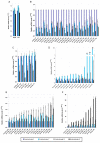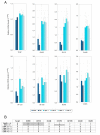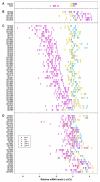RNA profiles of rat olfactory epithelia: individual and age related variations
- PMID: 19954510
- PMCID: PMC2797534
- DOI: 10.1186/1471-2164-10-572
RNA profiles of rat olfactory epithelia: individual and age related variations
Abstract
Background: Mammalian genomes contain a large number (approximately 1000) of olfactory receptor (OR) genes, many of which (20 to 50%) are pseudogenes. OR gene transcription is not restricted to the olfactory epithelium, but is found in numerous tissues. Using microarray hybridization and RTqPCR, we analyzed the mRNA profiles of the olfactory epithelium of male and female Brown Norway rats of different origins and ages (newborn, adult and old).
Results: (1) We observed very little difference between males and females and between rats from two different suppliers. (2) Different OR genes were expressed at varying levels, rather than uniformly across the four endoturbinates. (3) A large proportion of the gene transcripts (2/3 of all probes) were detected in all three age groups. Adult and older rats expressed similar numbers of OR genes, both expressing more OR genes than newborns. (4) Comparisons of whole transcriptomes or transcription profiles of expressed OR genes only showed a clear clustering of the samples as a function of age. (5) Most OR genes were expressed at lower levels at birth than in older animals, but a small number of OR genes were expressed specifically or were overexpressed in newborns.
Conclusion: Not all OR genes are expressed at a detectable level. Pups expressed fewer OR genes than adult rats, and generally at a lower level; however, a small subset of OR genes were more strongly expressed in these newborn rats. The reasons for these differences are not understood. However, the specific expression of some OR genes in newborn olfactory epithelia may be related to the blindness and deafness of pups at birth, when these pups are heavily reliant on olfaction and their mother.
Figures










Similar articles
-
The human olfactory transcriptome.BMC Genomics. 2016 Aug 11;17(1):619. doi: 10.1186/s12864-016-2960-3. BMC Genomics. 2016. PMID: 27515280 Free PMC article.
-
Morphological and molecular features of the mammalian olfactory sensory neuron axons: What makes these axons so special?J Neurocytol. 2005 Mar;34(1-2):49-64. doi: 10.1007/s11068-005-5047-7. J Neurocytol. 2005. PMID: 16374709 Review.
-
Characterizing the expression of the human olfactory receptor gene family using a novel DNA microarray.Genome Biol. 2007;8(5):R86. doi: 10.1186/gb-2007-8-5-r86. Genome Biol. 2007. PMID: 17509148 Free PMC article.
-
Cellular localization of vasopressin V1a receptor messenger ribonucleic acid in adult male rat brain, pineal, and brain vasculature.Endocrinology. 1994 Oct;135(4):1511-28. doi: 10.1210/endo.135.4.7925112. Endocrinology. 1994. PMID: 7925112
-
Early events in olfaction: diversity and spatial patterns of odorant receptors.Recept Channels. 1993;1(4):259-66. Recept Channels. 1993. PMID: 8081724 Review.
Cited by
-
A unified nomenclature for vertebrate olfactory receptors.BMC Evol Biol. 2020 Apr 15;20(1):42. doi: 10.1186/s12862-020-01607-6. BMC Evol Biol. 2020. PMID: 32295537 Free PMC article.
-
An odor timer in milk? Synchrony in the odor of milk effluvium and neonatal chemosensation in the mouse.PLoS One. 2012;7(10):e47228. doi: 10.1371/journal.pone.0047228. Epub 2012 Oct 25. PLoS One. 2012. PMID: 23133511 Free PMC article.
-
Functions of human olfactory mucus and age-dependent changes.Sci Rep. 2023 Jan 18;13(1):971. doi: 10.1038/s41598-023-27937-1. Sci Rep. 2023. PMID: 36653421 Free PMC article.
-
Gene Expression Profiles of Main Olfactory Epithelium in Adenylyl Cyclase 3 Knockout Mice.Int J Mol Sci. 2015 Nov 30;16(12):28320-33. doi: 10.3390/ijms161226107. Int J Mol Sci. 2015. PMID: 26633363 Free PMC article.
-
Olfactory neurons obtained through nasal biopsy combined with laser-capture microdissection: a potential approach to study treatment response in mental disorders.J Vis Exp. 2014 Dec 4;(94):51853. doi: 10.3791/51853. J Vis Exp. 2014. PMID: 25549156 Free PMC article.
References
MeSH terms
Substances
LinkOut - more resources
Full Text Sources
Medical
Molecular Biology Databases

